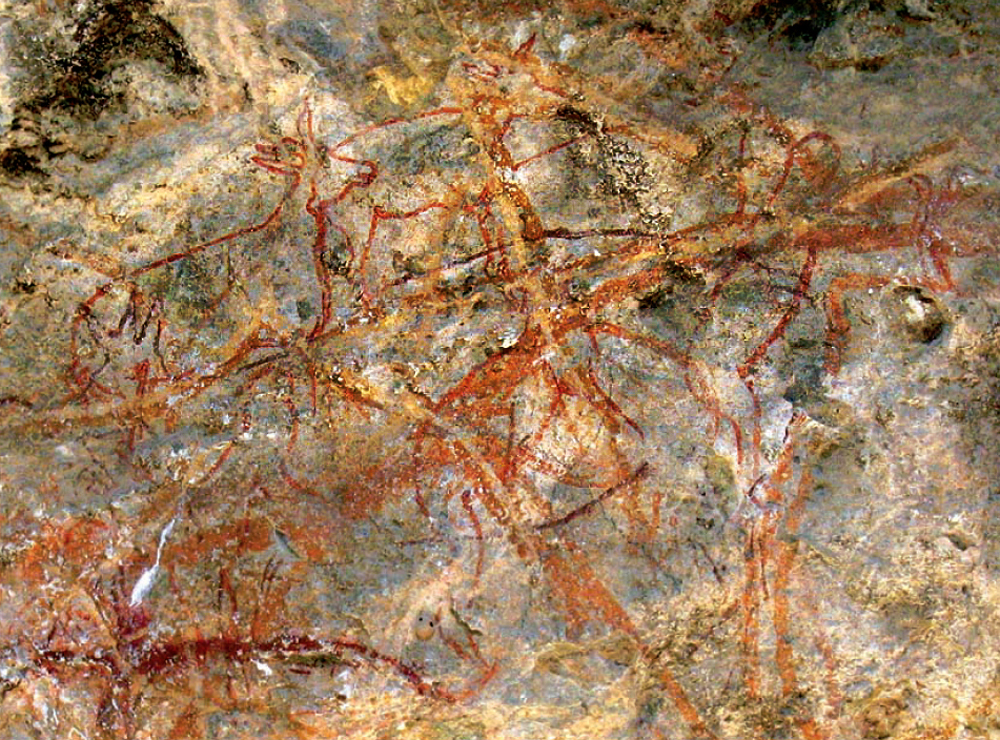


An article by Jordan Steinberg on gokunming.com - Ancient Yunnan rock art at risk - reports on the need for preservation of China's rock art.

Image: Paul S.C. Taçon
In July, the UNESCO World Heritage Committee recognized the cultural and historical importance of the Zuojiang Huashan Rock Art Cultural Landscape, inscribing it as the forty-ninth such site in China. With its ascendancy, the international organization described Zuojiang Huashan in the following statement:
'Located on the steep cliffs in the border regions of southwest China, these 38 sites of rock art illustrate the life and rituals of the Luoyue people. In a surrounding landscape of karst, rivers and plateaux, they depict ceremonies that have been interpreted as portraying the bronze drum culture once prevalent across southern China. This cultural landscape is the only remains of this culture today.'
Jinsha River rock art at risk #China #UNESCO #Yunnan #Huashan https://t.co/0HibCY7u67 pic.twitter.com/7yPNasyaF3
— Bradshaw Foundation (@BradshawFND) September 2, 2016
The newly-acquired UNESCO status has generated a renewed interest in similar regions around China. In Yunnan, the rock art of Jinsha River is one such an example. At 3,000 years old, numerous rock paintings of a consistent nature can be found along the Jinsha River where it demarcates the border of Yunnan and Sichuan. Depicting ancient dances, game animals and hunting rituals, the paintings are thought to have been the product of an ancient, but still mysterious, nomadic civilization.

Image: YNKGS
As a result of the attention to ancient art in Guangxi, questions of preservation have come to the fore in Yunnan. In the case of Zuojiang Huashan, even with its newfound UNESCO protection, changing weather patterns and myriad construction projects - including dams, railways, and mines - are threatening the integrity of the ancient sites in a way the intervening eons never could. Due to its obscurity, Jinsha River Rock Art may be at even greater risk.
Considering the number of development projects along the Jinsha River region, the future of this art is in serious jeopardy. In particular, the Baihetan Hydroelectric Dam scheduled for completion in 2021 puts the entire area at risk. While the Yunnan Provincial Institute of Archaeology and the local cultural relics management department have attempted to implement a protection plan, tourists are reportedly taking the opportunity to visit the paintings while they still can.

Image: Paul S.C. Taçon
In both Shangri-la and Yulong counties, Jinsha River Rock Art has been added to the list of national key cultural relics in need of protection. This makes the site eligible for preservation funds from national coffers, but those have not yet been forthcoming. Exacerbating the situation, the Jinsha River relics are located in one of the poorest regions of Yunnan - itself one of the 'poorest provinces' in China. As such, any local funding has been scant, to say the least. At present, a mere two thousand yuan has been allocated annually, put toward the salary of a single man tasked with 'protecting' paintings mostly hidden away on cave walls.
More information is available on the rock art of the Jinsha River region in a paper by Paul S.C. Taçon et al:
Naturalism, Nature and Questions of Style in Jinsha River Rock Art, Northwest Yunnan, China
Cambridge Archaeological Journal 20:1, 67-86
Paul S.C. Taçon is Professor of Anthropology and Archaeology in the School of Humanities, Griffith University, Queensland. He has conducted archaeological and ethnographic fieldwork since 1980 and has over 70 months' field experience on four continents. Professor Taçon has co-edited three books (including The Archaeology of Rock-art with Christopher Chippindale) and published over 150 academic and popular papers on prehistoric art, body art, material culture, colour, cultural evolution, identity and contemporary Indigenous issues.
China Rock Art Archive:
http://www.bradshawfoundation.com/china/index.php
The rock art of Huashan - Zuojiang Huashan Rock Art Cultural Landscape:
by Bradshaw Foundation
Monday 03 February 2025
by Bradshaw Foundation
Friday 09 August 2024
by Bradshaw Foundation
Wednesday 24 July 2024
by Bradshaw Foundation
Thursday 04 July 2024
by Bradshaw Foundation
Monday 01 July 2024
by Bradshaw Foundation
Wednesday 20 March 2024
by Bradshaw Foundation
Tuesday 13 February 2024
by Bradshaw Foundation
Tuesday 13 February 2024
by Bradshaw Foundation
Thursday 01 February 2024
by Bradshaw Foundation
Tuesday 28 November 2023
by Bradshaw Foundation
Thursday 23 November 2023
by Bradshaw Foundation
Monday 20 November 2023
by Bradshaw Foundation
Tuesday 31 October 2023
by Bradshaw Foundation
Thursday 26 October 2023
by Bradshaw Foundation
Wednesday 20 September 2023
by Bradshaw Foundation
Monday 17 July 2023
by Bradshaw Foundation
Monday 03 February 2025
by Bradshaw Foundation
Friday 09 August 2024
by Bradshaw Foundation
Wednesday 24 July 2024
by Bradshaw Foundation
Thursday 04 July 2024
by Bradshaw Foundation
Monday 01 July 2024
by Bradshaw Foundation
Wednesday 20 March 2024
by Bradshaw Foundation
Tuesday 13 February 2024
by Bradshaw Foundation
Tuesday 13 February 2024
by Bradshaw Foundation
Thursday 01 February 2024
by Bradshaw Foundation
Tuesday 28 November 2023
by Bradshaw Foundation
Thursday 23 November 2023
by Bradshaw Foundation
Monday 20 November 2023
by Bradshaw Foundation
Tuesday 31 October 2023
by Bradshaw Foundation
Thursday 26 October 2023
by Bradshaw Foundation
Wednesday 20 September 2023
by Bradshaw Foundation
Monday 17 July 2023
Friend of the Foundation











